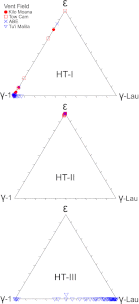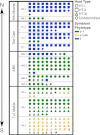Evidence for the role of endosymbionts in regional-scale habitat partitioning by hydrothermal vent symbioses
- PMID: 23091033
- PMCID: PMC3511114
- DOI: 10.1073/pnas.1202690109
Evidence for the role of endosymbionts in regional-scale habitat partitioning by hydrothermal vent symbioses
Abstract
Deep-sea hydrothermal vents are populated by dense communities of animals that form symbiotic associations with chemolithoautotrophic bacteria. To date, our understanding of which factors govern the distribution of host/symbiont associations (or holobionts) in nature is limited, although host physiology often is invoked. In general, the role that symbionts play in habitat utilization by vent holobionts has not been thoroughly addressed. Here we present evidence for symbiont-influenced, regional-scale niche partitioning among symbiotic gastropods (genus Alviniconcha) in the Lau Basin. We extensively surveyed Alviniconcha holobionts from four vent fields using quantitative molecular approaches, coupled to characterization of high-temperature and diffuse vent-fluid composition using gastight samplers and in situ electrochemical analyses, respectively. Phylogenetic analyses exposed cryptic host and symbiont diversity, revealing three distinct host types and three different symbiont phylotypes (one ε-proteobacteria and two γ-proteobacteria) that formed specific associations with one another. Strikingly, we observed that holobionts with ε-proteobacterial symbionts were dominant at the northern fields, whereas holobionts with γ-proteobacterial symbionts were dominant in the southern fields. This pattern of distribution corresponds to differences in the vent geochemistry that result from deep subsurface geological and geothermal processes. We posit that the symbionts, likely through differences in chemolithoautotrophic metabolism, influence niche utilization among these holobionts. The data presented here represent evidence linking symbiont type to habitat partitioning among the chemosynthetic symbioses at hydrothermal vents and illustrate the coupling between subsurface geothermal processes and niche availability.
Conflict of interest statement
The authors declare no conflict of interest.
Figures








References
-
- Chase JM, Leibold MA. Ecological Niches: Linking Classical and Contemporary Approaches. Chicago: Univ of Chicago Press; 2003.
-
- Leibold MA, McPeek MA. Coexistence of the niche and neutral perspectives in community ecology. Ecology. 2006;87(6):1399–1410. - PubMed
-
- Chesson P. Mechanisms of maintenance of species diversity. Annual Review of Ecology and Systematics. 2000;31:343–366.
-
- Schoener TW. Resource partitioning in ecological communities. Science. 1974;185(4145):27–39. - PubMed
-
- Schoener TW. Resource partitioning. In: Kikkawa J, Anderson DJ, editors. Community Ecology: Pattern and Process. Boston: Blackwell Scientific Publications; 1986. pp. 91–126.
Publication types
MeSH terms
Substances
Associated data
- Actions
- Actions
- Actions
- Actions
- Actions
- Actions
- Actions
- Actions
- Actions
- Actions
- Actions
- Actions
- Actions
- Actions
- Actions
- Actions
- Actions
- Actions
- Actions
- Actions
- Actions
- Actions
- Actions
- Actions
- Actions
- Actions
- Actions
- Actions
- Actions
- Actions
- Actions
- Actions
- Actions
- Actions
- Actions
- Actions
- Actions
- Actions
- Actions
- Actions
- Actions
- Actions
- Actions
- Actions
- Actions
- Actions
- Actions
- Actions
- Actions
- Actions
- Actions
- Actions
- Actions
- Actions
- Actions
LinkOut - more resources
Full Text Sources
Molecular Biology Databases

